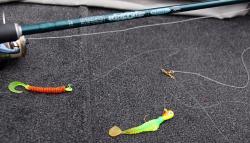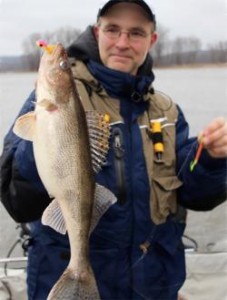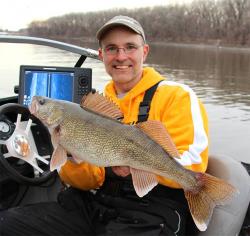A Double-Barreled Approach for Spring River Walleyes
Dr. Jason Halfen
www.technologicalangler.com
River anglers are renowned for developing unique rigs and bait presentation methods to help them tackle their ever-changing, current-driven environment. Many of these rigs have unique names that refer to their developer or place of origin, like the venerable “Wolf River Rig” that has put so many walleyes and white bass in anglers’ nets over the decades. One of my favorite river rigs for both early- and late-season walleye fishing, when the water is generally running high, fast and dirty, is one that simultaneously offers two opportunities to catch walleyes and sauger within the lowest portions of the water column. That exceptionally versatile, double-barreled rig for targeting river whitetips is the Dubuque Rig.
The Dubuque Rig can be dressed with a wide variety of live and artificial baits, although soft plastic offerings from B-Fish-N tackle are mainstays in most instances.The Dubuque Rig is designed for trolling, generally upstream (although downstream is possible when flows are low), and is centered around a standard 3-way swivel. Attach your main line to one of the swivel eyes. To a second and third eyes, attach mono leaders with two different lengths: a “short” leader that is about a foot in length, and a “long” leader that is 24-30″ in length. We will use these mono leaders to connect two baits to the rig. I tie a heavy jig (1/2-3/4 oz) to the long leader, and dress that jig with a bulky soft plastic like a 4″ ringworm or a Pulse-R Paddletail from B-Fish-N Tackle. I prefer to tie a light jig (1/16 oz) to the short leader, and dress that jig with a low-profile soft plastic like a shortened ringworm or a small fluke-style bait. These two baits, presented at two different depths, provide the angler with the opportunity to target walleyes feeding close to the bottom, as well as those that might be tempted to rise several feet off the bottom to strike.
The Dubuque Rig is designed to be presented from a moving boat. Position your boat downstream of your intended fishing area, and start moving upstream at a speed of 0.5-0.8 mph. I rely on my Minn Kota Ulterra 112 to provide me with quiet, consistent power throughout a long day of targeting spring walleye in heavy current. With the boat moving, lower the rig into the water, allowing the heavier jig to contact the bottom. Present the rig with a series of lifts and drops, releasing enough line to allow the heavy jig to remain in contact with the bottom during the drop. It is important, however, to resist the temptation to simply drag the lower jig across the bottom, as this is a sure-fire way to donate tackle to the river gods. In high-flow areas, you will likely notice that most of your bites occur on the bottom jig, while the top bait, fluttering off the bottom, will be a key producer under low-flow conditions and in cleaner water. As such, this double-barreled approach excels under a wide variety of river flow and clarity conditions that anglers encounter throughout the year.
Introduced just last year, St. Croix Avid X series has become a mainstay for river walleye enthusiasts.The Dubuque Rig is quite versatile. Common modifications include using a much longer leader for the “upper” bait, and connecting that leader to a long-shank live bait hook dressed with a minnow, leech, or the front half of a nightcrawler. In some parts of the walleye belt, a trolling fly will take the place of the bare hook. Another variation is to attach a small floating crankbait to this elongated leader, allowing the heavy jig and the bottom of the rig to pull this crankbait down to depth. Likewise, some anglers will cast a Dubuque Rig to fish the front faces of wingdams from fixed position, maintained by using the Spot Lock feature of the Minn-Kota i-Pilot Link system. Day in and day out, however, I use the Dubuque Rig as described above, with two jigs each dressed with a soft plastic, presented from a moving boat.
When you fish the Dubuque Rig, you’ll be presenting relatively heavy baits in moving water, and as such, this is no place for a wimpy walleye rod. Two rods are particularly well-suited for presenting the Dubuque Rig. On the spinning side of the family, I like a St. Croix 6’8″ MXF rod, which you can find in series ranging from the Eyecon all the way to the Legend Xtreme. I like the same length and action in the Avid X casting series; look for the AXC68MXF to find a rod that can pull double duty for chasing walleyes and summer bass. When paired with a casting reel that features a flippin’ switch, presenting the Dubuque Rig with casting gear can be accomplished with a minimum of angler effort. When fishing either rod style, spool up with 20 lb test braid, and you’re ready to hit the river.



